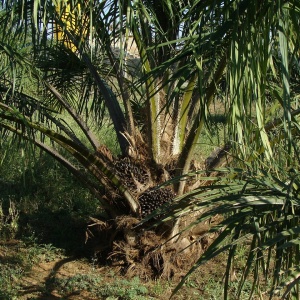
FCRN member Susannah Fleiss is the lead author of this paper, which finds that setting aside areas of forest (conservation set-asides) within oil palm plantations plays a vital role in storing carbon and boosting rainforest biodiversity within plantations.
The study was conducted using field data collected in Sabah, Malaysian Borneo. It finds that set-aside areas can store more above-ground carbon than oil palm plantations. Where a tenth of an oil palm plantation's land is protected as forest, an oil palm plantation can store up to 20% more carbon than plantations with no protected forest. Furthermore, the set-aside areas with the highest carbon storage also had the highest plant biodiversity.
The set-aside areas were found to contain fewer tree seedlings than primary rainforest, meaning that careful management is necessary if the set-aside areas are to continue to store carbon and support plant biodiversity in the future.
Abstract
Maintaining forest conservation set-asides is a key criterion of sustainability certification of many crops that drive tropical deforestation, but their value for carbon storage and associated biodiversity is unclear. We conducted vegetation measurements to examine the benefits of set-asides for aboveground carbon stocks (AGC) in certified oil palm plantations on Borneo, and whether their AGC is positively associated with plant diversity. The mean estimated AGC of live trees and palms ≥10 cm diameter in set-asides in certified oil palm plantations (52.8 Mg ha−1) was >1.5-times that of oil palm (30.3 Mg ha−1), with some plots supporting similar AGC to primary forest. For lowland Borneo, we estimate that the average AGC of oil palm plantations with 10% coverage of set-asides is up to 20% greater than the average AGC of oil palm plantations without set-asides, newly demonstrating carbon storage as a benefit of conservation set-asides. We found positive relationships between AGC and plant diversity, highlighting the carbon–biodiversity co-benefits of set-asides. However, set-asides had a lower density of tree seedlings than continuous primary forest, indicating potential suppression of future tree regeneration and AGC. Our findings support the application of zero-deforestation during agricultural development, to conserve areas of remaining forest with high AGC and high biodiversity. We recommend management practices that boost regeneration in existing set-asides (e.g. enrichment planting), which would be most effective in larger set-asides, and could substantially increase the AGC of agricultural landscapes without removing land from production, and help conserve forest-dependent biodiversity.
Reference
Fleiss, S., Waddell, E.H., Ola, B.B., Banin, L.F., Benedick, S., Sailim, A.B., Chapman, D.S., Jelling, A., King, H., McClean, C.J. and Yeong, K.L., 2020. Conservation set-asides improve carbon storage and support associated plant diversity in certified sustainable oil palm plantations. Biological Conservation, 248, p.108631.
Read the full paper here. See also the Foodsource building block What is sustainable intensification?







Post a new comment »